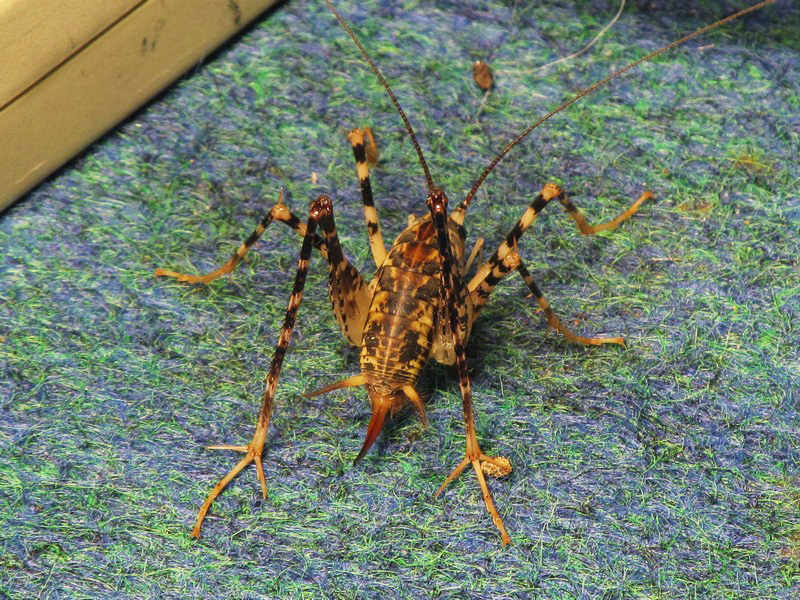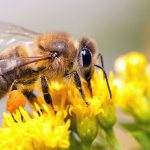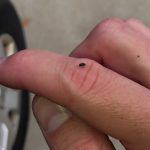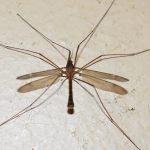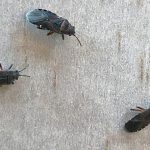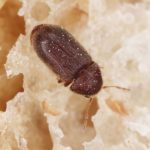Do you have a cricket infestation in your home?
If so, you may have heard that bleach can be an effective way to get rid of them. But does it really work?
The answer is yes. Bleach contains sodium hypochlorite, which is poisonous to insects like crickets.
When exposed to this chemical, the cells in a cricket’s body become damaged and they eventually die. However, it’s important to note that this process doesn’t happen right away – a cricket exposed to bleach can take hours or even days to die.
In this blog post, we’ll explain how and why bleach kills crickets as well as the potential risks associated with using this technique. We’ll also provide advice on how to safely and effectively remove crickets from your home without putting yourself or your family at risk.
Although bleach can be an effective way to get rid of crickets, there are some potential dangers involved with using it. Bleach is extremely corrosive and if not used properly, it can cause significant skin and eye damage.
In addition, using too much bleach can leave behind corrosive residue that could be dangerous for humans and pets alike. To sum up, bleach can be a safe way to get rid of crickets in your house but should only be done with caution and care.
Stay tuned for more information about how to safely and effectively get rid of pesky cricket infestations.
Does Bleach Kill Crickets?
Contents
- 1 Does Bleach Kill Crickets?
- 2 How to Use Bleach as an Insecticide
- 3 Safety Tips for Using Bleach as an Insecticide
- 4 How Long Does It Take for Bleach to Kill Crickets?
- 5 Alternatives to Using Bleach on Crickets
- 6 Natural Solutions for Killing Crickets
- 7 Essential Oils That Can Help Repel or Kill Crickets
- 8 Diatomaceous Earth: A Natural Way to Get Rid of Pests
- 9 Conclusion
Bleach has insecticidal properties that can kill crickets on contact, making it an ideal remedy for those who want to get rid of pesky rodents quickly. However, before using bleach, it’s important to understand how it works and how to use it safely.
Bleach is a corrosive chemical that can penetrate the exoskeleton of insects and damage their internal organs. When crickets come in contact with bleach, they will dehydrate and eventually die.
But bleach is not a targeted insecticide and can harm other beneficial insects, plants, and animals in the environment. It’s essential to dilute it properly according to the manufacturer’s instructions and avoid mixing it with other cleaning chemicals, as this can release harmful gases.
Alternatively, natural remedies such as essential oils or diatomaceous earth may be a more suitable option for those who prefer to avoid harsh chemicals in their homes and gardens.
How to Use Bleach as an Insecticide
Crickets can be an annoying nuisance, and they often need specialist assistance to eliminate them completely. However, bleach can be an effective insecticide against crickets if used correctly.
Diluting the Bleach
The first step is to dilute the bleach with water in a ratio of 1:10 (one cup of bleach to ten cups of water). This will reduce the potential for harm to people, pets, and plants. The diluted solution can then be poured into a spray bottle for rapid application.
Identifying the Infested Areas
Once you have prepared the solution, it’s time to identify the areas where crickets are prevalent, indoors or outdoors.
Crickets are often found in dark, humid, and damp locations such as under the sink, in bathrooms, laundry rooms, or basements. So make sure you check these areas thoroughly before spraying the solution.
Spraying the Solution
Once all infested areas have been identified, apply the diluted bleach solution directly onto surfaces where crickets are hiding. To floors, walls, baseboards, and any other places where crickets are present, spray it.
Allow the treatment to sit on these surfaces for at least 30 minutes before rinsing it off with water; afterwards wipe down all surfaces dry.
Repeat Process
For severe infestations repeat this process several times over two weeks until all crickets are gone from your house or garden space.
It’s important to note that bleach may not kill crickets immediately so it could take several applications before they are completely eradicated from your space; also remember that bleach can damage fabrics and surfaces so make sure you use it only in areas where there is no risk of damage.
Safety Precautions
When using bleach improperly or without protective equipment such as gloves, a mask and goggles it is important to be cautious since it can irritate eyes nose and throat and potentially cause skin irritation or chemical burns.
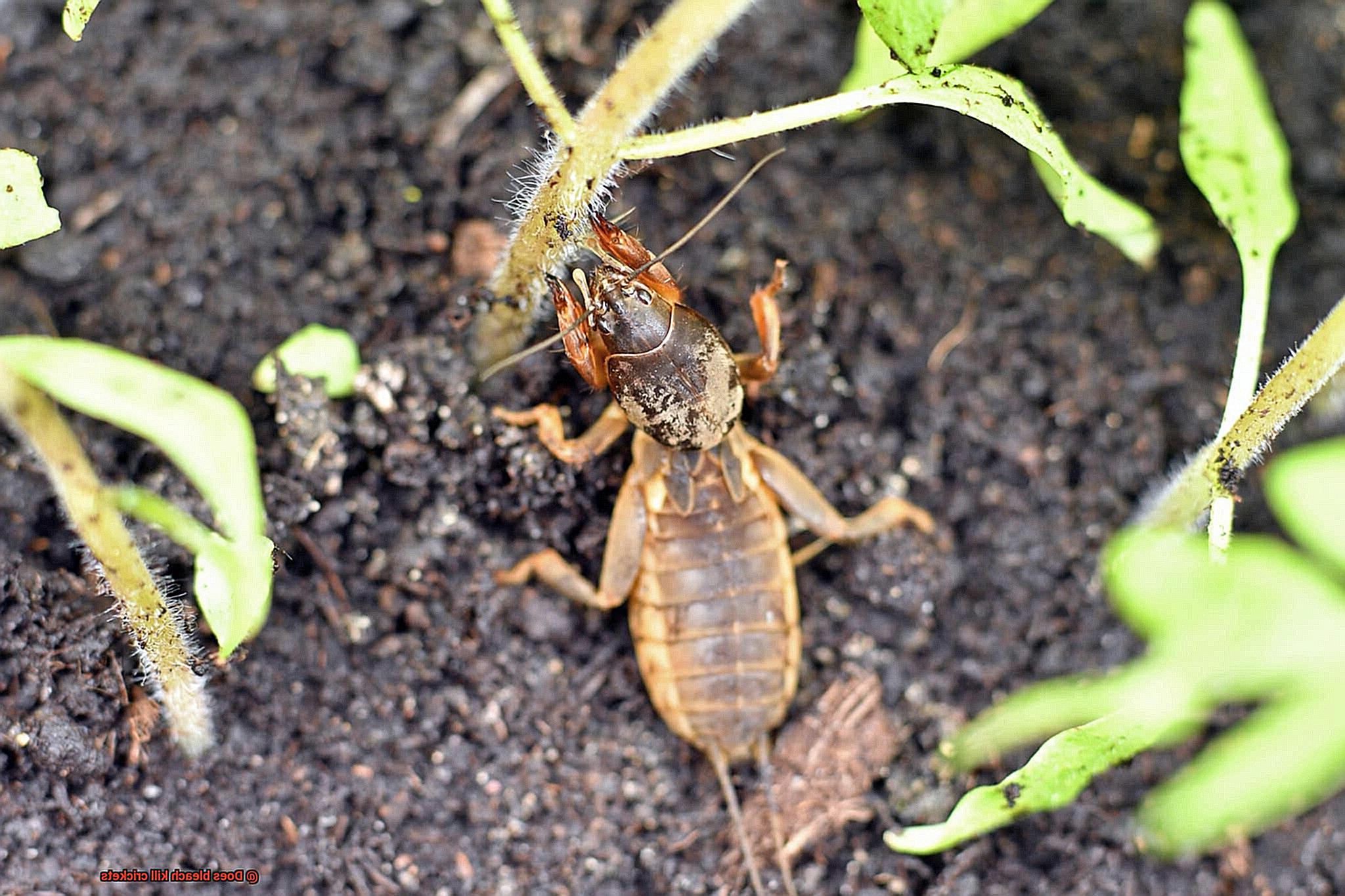
Furthermore, avoid mixing bleach with other chemicals such as acids or ammonia which can create a dangerous gas if inhaled by humans or pets living in your house or garden space.
Safety Tips for Using Bleach as an Insecticide
Using bleach as an insecticide can be an effective solution, but safety should always come first. To help protect yourself and others, here are five essential tips to keep in mind when using bleach as an insecticide.
Wear Protective Gear
Before handling bleach, it’s important to wear the right protective equipment – gloves, goggles, and a mask – to prevent contact with your skin, eyes, and respiratory system.
Avoid Mixing Bleach with Other Chemicals
Never combine bleach with other chemicals as this could lead to hazardous reactions that could be harmful to your health.
Ventilate the Area
When using bleach indoors, make sure the area is well ventilated so that you don’t breathe in any fumes from the bleach.
Use Diluted Bleach
Always use diluted bleach by mixing one part of bleach with ten parts of water and using it as a spray or wipe; never use undiluted bleach as it can be very toxic.
Keep Bleach Away from Children and Pets
Bleach can be dangerous if ingested, so ensure that it is kept out of reach of children and pets at all times.
How Long Does It Take for Bleach to Kill Crickets?
When it comes to killing crickets with bleach, the time it takes to get the job done depends on a variety of factors, including the concentration and amount of bleach used.
Bleach is a powerful cleaning agent that can be used to kill many types of insects on contact, including crickets.
However, it’s worth noting that using bleach is not the most effective or humane approach for controlling cricket populations as it can also harm other living organisms and ecosystems.
In order to use bleach safely and effectively for killing crickets, dilute it with water first to reduce its potency and make it safer for use around children and pets. This will also slow down the rate at which bleach kills crickets, giving you more control over how quickly the pest population is reduced.
Additionally, you may need to apply bleach multiple times in order to completely eradicate crickets from your home or yard as it can take a while for bleach to penetrate the insect’s exoskeleton and kill them from within.
Overall, while bleach can be used to kill crickets, there are other methods available that are more effective and humane.
Alternatives to Using Bleach on Crickets
There are several natural and chemical-free solutions available to help you get rid of these pesky insects. From essential oils to sticky traps, there’s something for everyone.
Vinegar
Vinegar is one of the most popular natural remedies for killing crickets. It’s an acid-based solution that can effectively eliminate crickets on contact.
To use vinegar, simply mix equal parts of water and white vinegar in a spray bottle and apply it directly onto the crickets or their hiding places. Essential oils are also a great way to keep crickets away from your home.
Oils
Oils such as peppermint, eucalyptus, and tea tree oil are known to repel these pests. To use essential oils, mix a few drops with water in a spray bottle and apply it wherever crickets tend to hide.
Diatomaceous earth
Diatomaceous earth is another effective insecticide that does not contain any harsh chemicals. This fine powder is made from the remains of tiny aquatic organisms and works by dehydrating insects.
Just sprinkle it around areas where crickets appear, and it will cling to their bodies, ultimately causing them to dry out and die. Sticky traps can also be used to discourage cricket populations without resorting to harsh chemicals.
These traps attract crickets with a scent and then trap them in a sticky adhesive. Sticky traps come in many different shapes and sizes, making it easy to find one suitable for your needs.
Plants
Plants such as lavender, geraniums, and marigolds emit scents that are unpleasant to insects including crickets – so planting some around your house could be beneficial.
Natural Solutions for Killing Crickets
There are several effective methods for eliminating crickets from your home. Diatomaceous earth is a natural powder made from the fossilized remains of tiny aquatic organisms called diatoms.
- Sprinkle it around common areas where crickets are present, such as entryways, windowsills, and corners – the abrasive powder will scratch their exoskeletons and cause them to dehydrate and die. Essential oils such as peppermint, lavender, and eucalyptus are also useful natural repellents against crickets.
- Mix a few drops with water in a spray bottle and spritz around areas where crickets are present. Sticky traps are another popular alternative – simply place them near areas where crickets are commonly found and they will be trapped by the sticky surface.
- Boric acid powder can also be sprinkled around areas where crickets are present – when they groom themselves, they will ingest the powder and die. In addition to these natural remedies, it’s important to keep your house clean and free of clutter to discourage crickets from making themselves at home.
- Regular vacuuming, dusting, and sweeping will go a long way in preventing them from entering your house while sealing any cracks or entryways will stop them from entering in the first place.
Essential Oils That Can Help Repel or Kill Crickets
While they may be a nuisance, you don’t have to resort to harsh chemicals to get rid of them.
Essential oils are a safe and effective way to repel or even kill crickets without putting your family’s health at risk. Peppermint oil is one of the most effective essential oils for repelling crickets.
Crickets find this oil unpleasant, causing them to avoid treated areas. Lemongrass oil is another great choice for repelling these insects, as it can be applied directly to areas where they are present.
Other useful essential oils include lavender, thyme, and tea tree oil. Essential oils can be used in various ways to repel or kill crickets.
Mix a few drops of the chosen essential oil with water and spray it onto surfaces where crickets are known to be present, or place cotton balls soaked in essential oils in areas where these pests are seen.
These methods are not only effective but also safe for both humans and pets in comparison to synthetic insecticides that can cause harm.
While essential oils can be an effective tool for controlling cricket populations, they should not be used as a standalone method.
For the best results, use these natural remedies as part of an overall pest control plan that includes sanitation and exclusion measures such as sealing cracks and gaps in windows and doors which will make it harder for crickets to enter your home in the first place.
Diatomaceous Earth: A Natural Way to Get Rid of Pests
If you’re looking for a natural, eco-friendly way to get rid of pests like crickets, diatomaceous earth could be the solution.
This naturally occurring sedimentary rock is composed of fossilized remains of diatoms and is widely used as an insecticide due to its abrasive properties.
When insects come into contact with diatomaceous earth, they absorb the fine powder and dry out, leading to their eventual death.
Diatomaceous earth is generally safe for humans and animals, but it’s important to use food-grade diatomaceous earth and avoid inhaling the dust.
It can be applied in cracks, crevices, and other areas where crickets may be hiding, as well as outdoor areas such as gardens or around the perimeter of a home.
This natural insecticide has long-lasting effects – it can continue killing insects for weeks or even months after initial application.
However, it’s important to note that if it becomes damp or wet, it will lose its effectiveness – so make sure you use it in dry environments only.
Conclusion
In conclusion, there are a variety of ways to get rid of crickets without using harsh chemicals.
From essential oils and diatomaceous earth to traps and repellents, there are natural solutions that won’t put you or your family in harm’s way.
Bleach is a powerful insecticide against crickets, but it should be used with caution as it can cause skin and eye irritation.
When handling bleach, always wear protective gear – gloves, goggles, and a mask – and dilute the bleach with water at a 1:10 ratio before use. Additionally, never mix bleach with other cleaning agents.
Essential oils, sticky traps, and diatomaceous earth are all great options for reducing cricket populations without risk to humans or pets.

